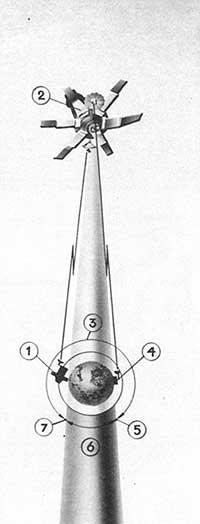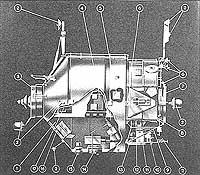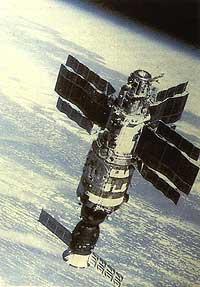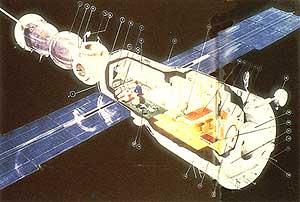MIR station, peace road to take advantage of the space around the earth

2. Satellite Luch Emisor (H = 36,000 km).
3. Field of communication.
4th Ground station with satellite communication.
5. End of the communication
framework 6. Area not communicable by radio.
7. Beginning of the communication framework.
The cosmonauts came to her in the so-called "Soyuz" spaceships and distributed loads. Once the research program was completed, they returned to the ground in space launches. Thus, and thanks to these seasons, man could work in orbit with Earth for a maximum of two months. On the other hand, these trips provided sufficient information on motor-thrusters, guidance systems, forms of energy supply, survival control, etc.
The first trips of Saliut allowed to reconstruct scientific knowledge: Especially in the study of the natural resource of the Earth, in astrophysics and in geophysics and physics that studies the immensity. In addition, they demonstrated that people who were researching in the Cosmos were actively involved in research.
However, science claimed that the performance of its work could be improved by stating that the station's supply system had to be reorganized. The results of the actions carried out by the cosmonauts depended heavily on this reorganization. The less you need the cosmonauts, the more they benefit. Therefore, spent substances (fuel, food - about 15 kg per person per day -, cinematographic and photographic films, experimental samples of materials and objects, tools to be replaced in travel, etc.) space stations that had to allow comfortable access.
With what the Soviet and Space scientists saw, the construction of second generation orbital stations was used. These had two coupling systems if necessary to pair two transport space vehicles simultaneously. In addition to the “Soyuz” used for the displacement of people (between Earth and orbit), transport aircraft were launched: Light aircraft called "Progress" and heavy vehicles of the satellite series "Kosmos".
The success of the orbital stations "Saliut-6" and "Saliut-7" did not slow down the researchers' vision. The other way around: The experience gained in using the "Saliut" stations was taken into account when creating the new MIR station.
On February 20, 1986 the MIR orbital station was launched with the pitcher "Proton" on a trip of zero duration. This pitcher is one of the most powerful of the Soviets and has participated in many other works of this type. The initial mass of MIR was 21 tons. Two months before the end of this event, the satellite transmitter "Luch" was installed in the geostable orbit. The MIR station is in charge of maintaining communication with the ground stations.
The MIR orbital station maintains communication with ground stations for almost the whole day, through the satellite transmitter "Luch".
One of the main peculiarities of the MIR station is the improvement offered by the cosmonaut to rest and work: They did not have the stations of the series "Saliut". The main room is the local. The crew spends most of the time and that is why it has been designed to make it comfortable. Compared to the previous ones, it can be said that it is much greater. On the other hand, scientific teams and other research tools have emerged from it and have been grouped into isolated modules in order to carry out specialization research. These modules would be put into orbit shortly after at the station.

2. Antenna of the “needle” approach system;
3. Active link set;
4. Station equipment;
5. Svetlana electrophoresis plant;
6. Antenna for the "Kurs" approach system;
7. Passive linking group;
8. Scientific device room;
9. Fosvich X-ray telescope;
10. Siren-2 spectrometer;
11. Ultraviolet Glazar Telescope.
12. TTM X-ray telescope.
13. X-ray telescope "Press X-I".
14. Optical viewfinder;
15. Astroorientation device;
16. Control center.
17. Block for environmental control system.
The workroom of the MIR station has been painted following the use of the floor: dark colored pavement and walls and ceiling of light colors. This, in conditions of weightlessness, helps to differentiate the floor from the ceiling. It can reach up to 28 degrees of temperature. The mobile sphere is designed so that the eyes of the cosmonauts relax; when they look anywhere, you can see the whole room (and not just the wall). In addition to the large common room, they have simple rooms in which researchers can only be in their time.
In long-lasting trips, in addition to being comfort in such important normal things, it was mentioned the comfort that means that cosmonauts work with programmed monitors. It illuminates any information of interest to the crew. Electronic calculators are responsible for collection, classification and analysis. The station is equipped with seven calculators of this type. A computer center is responsible for many operations. For example, it helps to control the station, elaborates a graph indicating what is the most appropriate work distribution of the crew, tracks the emitting satellite "Luch", etc. As we can imagine, this new station is an example of comfort.
In addition, we will mention that with this tandem MIR/Luch, which has just started, the orbital laboratory uses the new system of communication with the Earth. Now, even if the land of the USSR is not crossed, it is possible to communicate with the land posts. The satellite "Luch" is located at a fixed point with respect to the Earth, turning with it. It is located around Baiconur, on the meridian and on the equatorial plane.
The MIR station crosses this area on each tour, allowing you to speak on the radio in 40 minutes with the Earth. In addition, taking into account special vessels that are separated by the world's oceans, it can be said that almost all day can be kept in contact with the Earth. This greatly improves and shapes the work of the cosmonauts. Consequently, the station's electronic computers have been combined with those on Earth in a single complex. This allows to automate the controls of the systems, assemblies and apparatus of the station. Specialists have tried to resolve the interactions between human machine systems found in the Cosmos and on Earth to make the interaction closer and more continuous. At present, progress has been made from ideas to experiment and how it can be observed successfully.
The most suitable technical solution for the new station, which is the starting point of all other innovations, is the port of multiple connections. It has six links, two of them main. These main links are located at the two ends of the station axis and their function is the approval of transport ships. In addition to these, there are four other side modules. Each of these modules is associated with a working model (astronomy, biology, metallurgy…). All modules must be docked in the longitudinal axis direction. Subsequently, and by a long arm, they are transferred to the sides of the station. Consequently, the flow of goods on the Lurra-Kosmo main route will increase, allowing cosmonauts to have more scientific tools and additional equipment. On the other hand, the merchandise that comes to it (by staying inside a module) will not make any obstacles. The number of crews can also grow between 5 and 6 people, enough to increase the space needed. For this, it can be thought that the solution would be to send one of the modules in condition so that the cosmonauts can live. If necessary, other stations can be connected to the station "MIR" and thus double the current mass and volume of the station, obtaining an orbital station of large dimensions.
These additional scientific modules prevent heavy loading/unloading by gaining time. In addition, they offer comfort for work. For example, the module that has been prepared for biology can be replaced by another that has been prepared for astrophysics and, if necessary, prepared to work as a team. The technology module will not always be maintained with the initial tools. In their day they will be replaced by adapted tools. It is true that just as in previous seasons the effect of vibration cannot be avoided. Meanwhile, and as is known, there are trials that require total calm. However, specialists have the possible solution to create modules that float freely, that is, autonomous modules that float without any mechanical connection to the station. Once the research program is completed, the modules will be adapted to the station for a period of time to pass the research results and provide the necessary subjects. Another possibility would be that, from time to time, following in orbit the modules instead of tying them to the station, the cosmonauts would approach it in a transport vehicle, doing the work there, supplying new materials and returning later to the station. As can be seen, the MIR station can work with autonomous modules. Cosmonauts Leonid Kizim and Vladimir Soloviov developed this principle through the ship "Soyuz T-15". From MIR station they went to the station "Saliut-7", where after several works he returned to the station MIR. At the return, the research results and a total of 20 devices weighing almost 400 kg were transferred to the MIR station.

Thus, the MIR station has opened a new path in the development of space technology. In addition to connecting additional specialized modules, the MIR station can be used as a well-equipped orbital base for the service of other space vessels.
As the station is equipped with modules, designers and builders have taken into account that its initial mass and inertia will increase. In these conditions it would be very difficult to get the coupling position in comfort. In this situation it would burn too much fuel. Therefore, and to hide it, it will be the ship itself that surrounds the station until approaching the connection area. A similar system was used when the spacecraft "Soyuz TM" approached and tied to the MIR station.
In turn, the station must perform a series of maneuvers. Innovation has been introduced in the guidance system to gain fuel and time in maneuvers. Acceleration sensor information is stored in memory and used to determine the position of station axes in space. If the direction needs to be reoriented, the most suitable turning angle is automatically calculated and the necessary commands are sent to the operating sections.
In the spring of 1987 a new step has been taken in the conquest of space surrounding the Earth and in the history of international space cooperation. On 11 April at night, two months after the cosmonaut Yuri Romanenko and Alexander Laveikin arrived at the station in the vehicle of the second trip "Soyuz TM-2", the heavy module "Kvant" of astrophysics, which was orbited with the launcher Proton, joined the station. With this the mass of the station in orbit went to 51 tons and reached a length of 35 meters. On the other hand, it is true that once released the system used to perform the maneuvers of "Kvant" lost 10 tons. But not for time; if a transport vehicle is docked, it will gain the mass again.
The Kvant module is special. It was held after seven years of activity by specialists from the USSR and numerous laboratories and universities around the world. It is designed for multiple uses. Kvant is the first module associated with MIR station. In total, and in the short term, it is expected to send four other specialized modules. Consequently, a station in orbit with ramification of 100 tons of mass will be generated.
However, although the Kvant module could be used in multiple programs, it was named astrophysical module, as it was called stars, galaxies, cuasars, etc. complex and powerful research devices have been gathered.
The fact that the MIR station is in orbit and the use of scientific modules for different purposes has opened a new path in the cosmos, a path that now becomes especially important: "Pake-bidea".
But unfortunately it is not the only way we lead.

2. Vessel Soyuz TM
3. Adaptation module
4. Pilot position
5. Set of side links
6. Approach system
antenna 7. Working Room
8. Port of Langela
9. Post Control Center
12. Solar batteries
13. Exercise bike
14. Working table
15. Single room
16. Bathrooms
17. Lababoa
18. Satellite communication antenna
19. Axial link set
20. Mobile training floor
21. Mezzanine
22. One of the main engines
23. Diana
24. Tooling
25. Port cover step
26. Port
27. Port cover
Buletina
Bidali zure helbide elektronikoa eta jaso asteroko buletina zure sarrera-ontzian











